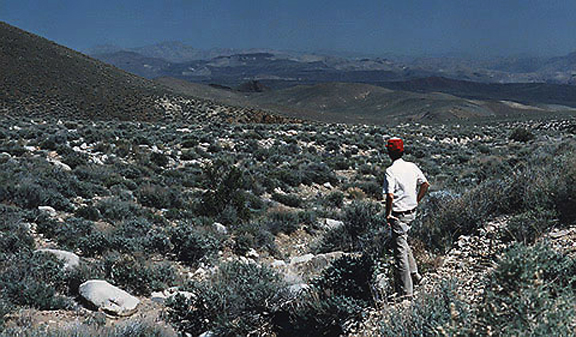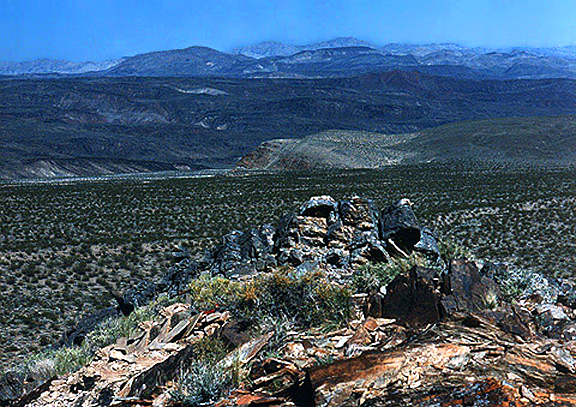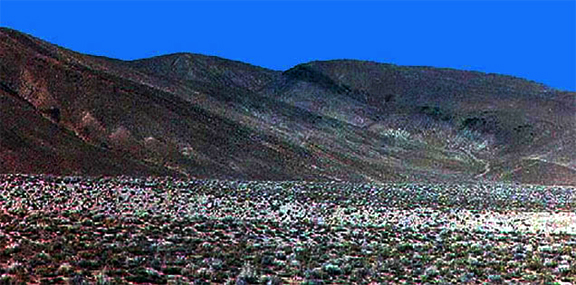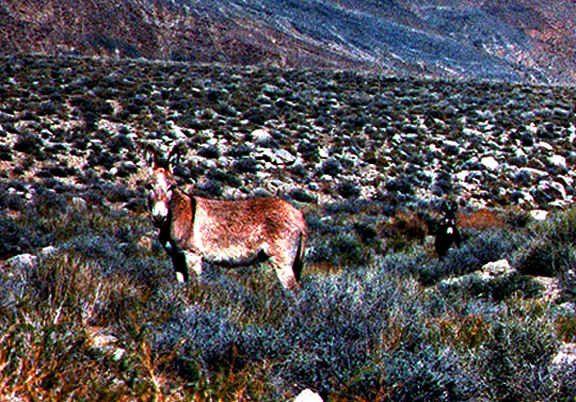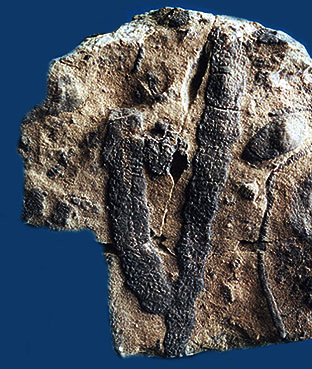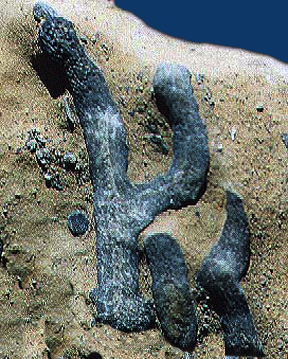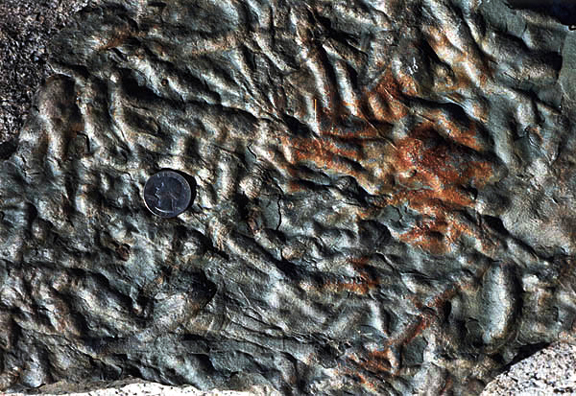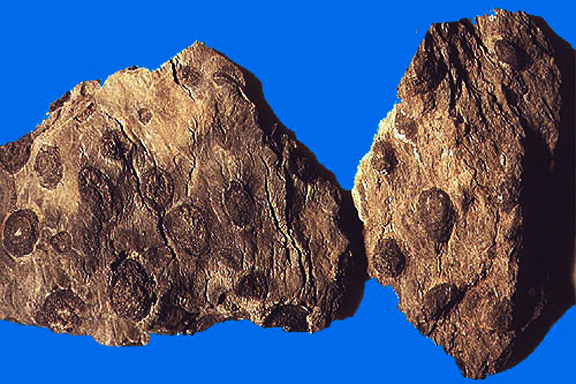|
Relatively few localities on Earth record the important
Precambrian-Early Cambrian transition period--a fascinating and
truly mysterious interval some 550 to 509 million years ago,
when abundant animal life with a hard external covering first
appears in the geologic record.
One of the best places to study this crucial boundary between
two major geological Eras (Precambrian and Paleozoic) is the
Waucoba Spring district some 35 miles southeast of Big Pine,
California, on the eastern slopes of the Inyo Mountains, a locality
that now lies within the northwestern border of Death Valley
National Park (as of 1994, when the Desert Protection Act became
law). Here can be found the classic Waucoba Spring geologic
section, first measured and described by legendary Cambrian specialist
Charles Doolittle Walcott in the 1890s.
Walcott is of course most famous for discovering the Middle
Cambrian Burgess Shale fauna of Canada, an extraordinary assemblage
of soft-bodied organisms also recognized from a specific Early
Cambrian site in China. But Walcott was vitally interested in
all aspects of the Cambrian Period, and his detailed analysis
of the Waucoba Spring geologic section elevated the site to the
status of type reference section for the Waucoban Series of the
lowermost Cambrian (542 to 509 million years ago). This means
that all age-equivalent strata in the world are correlated with
the Waucoba Spring rocks.
Not only is the important Precambrian-Cambrian boundary
well exposed near Waucoba Spring, but the sequence is amazingly
fossiliferous for strata of such profound antiquity. Among the
diverse fossil types that can be observed in situ at Waucoba
are archeocyathids, an extinct invertebrate animal that secreted
a conical to cup-shaped shell typically one-quarter to two inches
long--among the earliest reef-forming animals on Earth, it was
likely an early calcareous sponge, although not a few archeocyathid
purists still prefer to call it a unique organism with no known
modern analogs, deserving of its own scientific Phylum. There
are also worm trails, miscellaneous invertebrate tracks and trails
(probably from annelids and trilobitic arthropods), salterella
(an early experiment, now an extinct member of the Phylum called
Agmata, with a small tusk-shaped shell roughly a quarter inch
long), algal bodies, brachiopods, and trilobites. Most of the
fossil material is surprisingly well-preserved, and there is
even one specific site where perfect, intact trilobite carapaces
can be observed. Please note of course that the Waucoba Spring
geologic section presently resides within the borders of Death
Valley National Park. One must not remove fossil specimens within
the park's boundaries without formal, written approval from the
National Park Service personnel at Furnace Creek in Death Valley.
To reach the Waucoba Spring geologic section, first travel
to the intersection of Highway 395 and State Route 168 in Big
Pine, Owens Valley, California. Turn east on route 168 and proceed
2.4 miles to Death Valley Road (to Saline Valley, Eureka Valley,
and Scotty's Castle). Turn right here.
At the 2.3 mile mark from the SR 168, look to the north
of the road (left) and you will begin to see impressive badlands
carved in sedimentary rocks deposited in ancient Lake Waucoba--a
dominantly detrital sequence of calcareous silts and sands and
water-laid volcanic tuffs that accumulated 2.63 to 2.06 million
years ago during the Late Pliocene and Early Pleistocene.
In the 1890s, C.D. Walcott, on his way to the Early Cambrian
rocks exposed farther southeast, discovered an abundance of freshwater
snail fossils from several beds in the Plio-Pleistocene section.
For those interested in researching the original reference to
the molluscan assemblage, Walcott's paper appears in the Journal
of Geology, volume 5, 1897. In 2012, a scientific examination
of the Waucoba Lake Beds--their formal geologic name (though
some folks prefer "Waucobi Lake Beds")--disclosed numerous
species of ostracods (a minute bi-valved crustacean), as well.
When you have driven 13.5 miles from the SR 168, turn right
on Waucoba-Saline Road. This path can be followed all the way
through Saline Valley, just inside the westernmost boundary of
Death Valley National Park. It is for the most part a well-graded
dirt road, although the Whippoorwill Canyon area a few miles
up ahead tends to be rocky and rutted--a condition one would
expect to encounter on a dirt route through such a defile in
the mountains.
At the 8.1 mile point from Death Valley Road, Waucoba-Saline
Road begins to cut through one of the oldest recognizable sedimentary
rock formations in North America: the Wyman Formation. The dark-brown
to gray-brown exposures along either side of the path consist
of heat and pressure-altered sandstones and siltstones. Some
portions of the formation have been changed to quartzite through
the eons of tortuous metamorphism. From a distance, these Wyman
rocks have a suspicious volcanic aspect: a blocky, basalt-like
tone and style of outcropping. Closer examination, though, reveals
the obvious sedimentary nature of the material; the strata reveal
the characteristic layered bedding and fine-grained composition
of altered sandstones and siltstones.
No animal remains have been recovered from the Wyman Formation.
At this point in the local stratigraphic section you are standing
thousands of feet below the first occurrence of olenellid trilobites,
which in a traditional sense used to define the beginning of
the Cambrian Period and the Paleozoic Era. Not any longer, though.
The Precambrian-Cambrian boundary is now defined as either (1)
the appearance of a trace fossil called Treptichnus pedum
(feeding trails of a supposed annelid), or (2) a distinctive
negative carbon isotope excursion in the sediments at the boundary.
Rarely do the two defining occurrences--biological and geochemical--occur
together, but there's one place in Death Valley National Park
where such a unique combination of defining events can be studied.
It's in Boundary Canyon near Daylight Pass, along the road to
Beatty, Nevada, in the lower member of the Wood Canyon Formation.
Unicellular organisms and algae most certainly lived here
during Wyman time--nearly a billion or so years ago--but due
to intense metamorphism any trace of their former existence has
long since been obliterated. Still and all, a relatively
few pure limestone pods have been reported in the Wyman. If such
rocks could be located in the predominantly detrital terrigenous
terrain, one would naturally expect a greater opportunity to
discover some of the oldest identifiable animal fossils on Earth.
At a point 13.8 miles from Death Valley Road, the path
starts to slice through scenic Whippoorwill Canyon. Rocks exposed
here belong to the upper Precambrian Reed Dolomite and the Upper
Precambrian-Lower Cambrian Deep Spring Formation, roughly 560
to 542 million years old. In contrast to the predominantly detrital
Wyman Formation, these two rock units contain relatively high
percentages of carbonates, rocks composed of calcium carbonate
and magnesium carbonate (dolomite) precipitated on the floors
of vast shallow seas.
Near the very top of the Reed Dolomite, in strata transitional
with the younger Deep Spring Formation, scientists have found
one of the earliest evidences of a widespread variety of animals
with shells. Most of the described specimens are minute, measured
in millimeters (about one-twenty-fourth of an inch). But they
represent such identifiable forms as worm tubes and primitive
mollusks. I have personally scoured the Whippoorwill Canyon area
for fossils but have yet to find any there. The worm-tube/primitive
mollusk horizon occurs in the same formations at Mount Dunfey
in neighboring Esmeralda County, Nevada. It also shows up in
the Westgard Pass region several miles east of Big Pine. Even
so, this is an excellent place for paleontological explorations.
It is one of the most significant geologic regions in all the
world. Because most of the sedimentary material exposed here
is miraculously unaltered, there is great potential for the discovery
of the oldest identifiable animal with a shell.
An aside here. Another ultra-significant Precambrian-Cambrian
transitional stratigraphic section can be studied in the Alexander
Hills District, southeast of Death Valley National Park,
a California Mojave Desert locality that produces: Precambrian
stromatolites over a billion years old; early skeletonized eukaryotic
cells of testate amoebae around three-quarters of a billion years
old; and early Cambrian trilobites, archaeocyathids, annelid
trails, arthropod tracks, and echinoderm material.
For two miles the Waucoba-Saline Road carves through the
Precambrian strata of Whippoorwill Canyon. All along this route
you move gradually upsection--that is, as you proceed south the
rocks become progressively younger in geologic age. The base,
or the section bearing the oldest layers of the classic Waucoban
Spring section, as defined by pioneering paleontologist Walcott,
occurs in transitional rocks of the Late Precambrian-Lower Cambrian
Deep Spring Formation and the overlying lowermost Cambrian Campito
Formation. This world-famous change from the Precambrian to the
Paleozoic Era lies directly to the east of the Waucoba-Saline
Road, 16 miles from the Death Valley Road junction. To the left
of the road you will note typically blocky weathering black to
brownish quartzites and shales of the Andrews Mountain member
of the Campito Formation, within which some of the oldest olenellid
trilobites have been recovered. The fossils are by no means
common here--they are, indeed, frustratingly rare: one lone occurrence
discovered by a very lucky paleontologist, although unfortunate
evidence exists to conclude that perhaps that specimen came from
much younger strata; the trilobite was recovered from a wash
and could have been transported to the site of discovery. Outcrops
of the Andrews Mountain member in neighboring Esmeralda County
have yielded a few identifiable trilobite specimens.
After examining the exposures of the Campito Formation
here, proceed one additional mile to the turnoff to Waucoba Spring,
where you will be within a short hiking distance of fossiliferous
Early Cambrian strata in the Waucoba Spring geologic section.
Waucoba Spring lies approximately one-half mile west of Waucoba-Saline
Road, 17 miles south of the intersection with Death Valley Road.
The spring is an old and famous watering hole for the local
fauna, including feral burros whose presence in the Death Valley
region has generated much controversy. Some investigators claim
the burros foul critical watering holes and scare off more sensitive
creatures such as bighorn sheep. Others exonerate the asses,
pointing out that they have just as much right to exist in the
wild as any indigenous creature and charges that they are solely
to blame for the ruination of the ecology are absurd.
During my first visit to the Waucoba a number of years
ago, I recall having observed quite a few burros. They'd halt
right in front of a moving vehicle, staring inscrutably ahead.
Subsequent trips to the Waucoban wilds disclosed a dramatic drop
in the observable burro population. I do not know whether natural
selection has been weeding out the weak or artificial measures
have been employed--such as periodic thinning of the paces/herds
by gunfire.
Excellent representative exposures of the classic Early
Cambrian Waucoba Spring section described by Walcott lie to the
east of Waucoba-Saline Valley Road. To reach the fossil-bearing
exposures it is necessary to hike approximately a quarter of
a mile to the nearest hillslope, directly east of the turnoff
to Waucoba Spring. This slope is composed of the greenish shales
and quartzites of the Montenegro Member of the Campito Formation,
within whose detrital rocks can be seen worm trails, invertebrate
tracks (many made by trilobites, but also several types that
have not yet been positively identified) and trilobite head shields,
or cephalons (complete specimens rather rare). Another region
in which to hunt for the oldest reasonably common trilobites
in the geologic record is over in neighboring Esmeralda County,
Nevada, where several Montenegro Member sections yield many complete
Fallotaspis trilobites, along with several other early
spectacularly preserved olenellid trilobites.
As you continue to hike in a generally southeasterly direction
along the hillside, the greenish shales and quartzites give way
to geologically younger gray-blue to buff-brown archaeocyathid-bearing
limestones of the Poleta Formation. Most of the extinct calcareous
sponges range from a half-inch to two inches in length, and quite
a number of archeocyathid fragments have weathered out of the
rocks. A few of the more densely packed clusters of archeocyathids
observed in the limestones are likely the preserved remains of
primitive, localized reefs.
All of the trilobites within the Poleta Formation occur
in the younger, gray-green shales which lie directly on top of
the archeocyathid-bearing limestone. In addition to the trilobites,
perfect specimens of which remain elusively infrequent in the
extensive deposits of shale, abundant worm trails and invertebrate
tracks can also be seen. These fossiliferous shales are in striking
stratigraphic contact with the older archeocyathid limestone,
and the lithologic contrast is so distinctive that it can be
traced with assurance throughout the Waucoba Spring district
and western Great Basin, in general (northern Inyo County and
western Esmeralda County, Nevada).
Additional superior fossil material can be observed in
place from the next-youngest geologic rock unit in the Waucoban
section, the Harkless Formation. Abundant worm trails and invertebrate
tracks, salterella (diminutive tube-like, roughly conical shells
secreted by an extinct animal of unestablished zoological affinity),
and a few species of archeocyathids are characteristic of the
formation, which outcrops roughly three-quarters of a mile to
one mile directly east of the Waucoba Spring turnoff. The Harkless
is chiefly a terrigenous unit of gray shale and siltstone, interbedded
with brownish quartzites. Minor lenticular blue-gray limestones
in the youngest phases of deposition often yield large archeocyathids,
some up to nine inches in length.
Expect to conduct extended periods of hiking in order to
examine all of the fossil material present in the Waucoba geologic
section directly east of the turnoff to Waucoba Spring. The trilobites
in particular are seldom even common at any one locality. They
are usually confined to the greenish shales of the Poleta Formation,
several feet above the archeocyathid-rich limestones.
A better place in which to observe in situ trilobites lies
farther south, in much younger exposures of the Early Cambrian
Waucoba Spring geologic section at Algae Ridge, where the Lower
Cambrian Mule Spring Limestone contains abundant fossil remains
of a species of cyanobacterial blue-green algae called Girvanella.
The Mule Spring limestone contains the highest concentration
of fossil algae of any Cambrian formation in the Great Basin.
It is estimated that in some horizons Girvanella algal
bodies constitute fully 40 percent of the limestones by volume.
At Algae Ridge these fossil remains are certainly locally prolific,
appearing in the blue-gray rocks as oval to circular black concretionary
structures roughly one-quarter to three-quarters of an inch in
diameter.
The Mule Spring Limestone marks the very top, or youngest
part of the Waucoba Spring geologic reference section. Above
it lies the Middle Cambrian Monola Formation whose prominent
exposures can be seen about a mile and a half to the south, near
where the dramatic expanse of Saline Valley commences.
The prime trilobite locality lies on Algae Ridge in the
Saline Valley Formation. Prior to December 1994 this site was
open to hobby fossil collecting, lying as it did outside the
boundaries of Death Valley National Monument. Please note that
it now lies within the borders of Death Valley National Park.
Look and touch, but don't keep anything you find there--unless
it's a photograph of a fossil specimen, of course.
At the fossil site one can examine abundant trilobite head
shields, plus occasional perfect, intact specimens. During my
last visit to the site before it was assimilated by the national
park system, I was fortunate to find three complete, whole trilobites--a
powerfully exhilarating and rewarding experience, to be certain.
Perfect specimens were surprisingly common, interestingly enough--a
fact that helped set this specific Early Cambrian fossil site
apart from most others.
The Waucoba Spring district is a rugged and pristine land.
It is also out in the middle of nowhere, miles from civilization.
This means that adventurers traveling to the region must make
certain that their vehicles are in perfect working condition
and carry with them extra food, plenty of water, spare fan belts
(and know how to change one!) and protective clothing. In short,
take all necessary precautions to ensure a safe experience.
Most of my Waucoba Spring trips were during the early Spring,
mainly in early to mid April. I'm not presuming to suggest that
this is the most comfortable time of the year there, but by way
personal experience I recall one August spell that turned into
pure vapor lock of the brain--soaring daytime temperatures even
up in Whippoorwill Canyon at elevations over 7,000 feet--and
a brief stay in December practically froze my toes off.
The Waucoba district certainly contains one of the greatest
Early Cambrian stratigraphic sections in all the world: the classic
Waucoba Spring section first described by C.D. Walcott in the
late 1800s. Except for development of the graded Waucoba-Saline
Road and a few additional minor off-road-vehicle trails, the
region likely appears much the same as it did in 1897 when Walcott
first passed through. The Precambrian-Early Cambrian transition
exposed here records the preserved remains of plants and animals
that lived in this part of what is now the Great Basin some 600
to 510 million years ago--a time so distant, so primordial that
it echoes back to a moment when the Spirit moved over the face
of the waters and said, "Let there be light."
|
